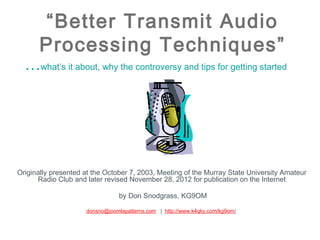
Transmitaudioprocessing
- 1. “Better Transmit Audio Processing Techniques” …what’s it about, why the controversy and tips for getting started Originally presented at the October 7, 2003, Meeting of the Murray State University Amateur Radio Club and later revised November 28, 2012 for publication on the Internet by Don Snodgrass, KG9OM donsno@joomlapatterns.com | http://www.k4qky.com/kg9om/
- 2. Introduction Better transmit audio processing techniques have gained considerable popularity over the past ten years. Studio quality microphones and external audio processing choices hardware or software based Now incorporated into most new HF transceiver design Learning more about emerging new computer assisted technologies
- 3. Overview What constitutes better transmit audio processing Why the controversy Resolving the issues Recommendations for those who want to learn more about better transmit audio processing Questions?
- 4. What constitutes better transmit audio processing? Conventional transmit audio processing tends to emphasize the mid range and typically sounds stringent. Narrow range communication grade microphones and built-in speech processors are often the norm. Better transmit audio processing is aimed at balancing the low, mid and high frequencies of the human voice. Can be accomplished with the use of hardware and even software based audio processing techniques aimed at achieving a more pleasing, natural and articulate sound. Full range microphones Click to edit Master text style External hardware including microphone preamps and effects processors Second leve Programmable EQ’s included in the design ofnewer HF transceivers Third level such as the Kenwood TS-590 • Fourth level External software based audio processing programs such as “Ableton Live” Fifth leve
- 5. Result Click to edit Master text styles Second level Third level • Fourth level Fifth level Balanced (flat) frequency response from 80 hz to 3.0 Khz with greater talk power with a more natural sound
- 6. Why the controversy? What’s good about audio What’s Not so good processing Hams who have modified Advances the state of the their transmitters to extend radio art their transmit bandwidth well Provides for beyond 3 Khz are more likely experimentation… to interfere with other nearby especially software based QSOs especially during processing systems. crowded band conditions. More pleasant to listeners Promotes greater Hams who prefer awareness of good conventional sounding audio operating practices often openly ridicule those Reduced IMD who experiment with the techniques described herein.
- 7. Resolving the controversy Part 97 is vague on many things including transmit bandwidth. Perhaps it should remain so to foster the continuance of our long and proud tradition of self-regulation. We need to be more tolerant of each other’s operating choices and styles. Besides, our hobby has bigger fish toClick to edit Master text styles fry including cracking down on: Second level Intentional interference Third level Foul language • Fourth level Poor operating practices Fifth level
- 8. Tips for getting started Achieving better transmit audio processing is not for everyone. However, those who may be interested, should first learn more about it: Visit websites including: http://www.nu9n.com/intro.html http://www.w3oz.com/v1enhanced%20audio%20main.htm http://groups.yahoo.com/group/ssbaudio/ Talk with other hams who enjoy experimenting with these techniques
- 9. Then, determine hardware and/or software needs External hardware processing: • Full range microphone • Microphone preamp • Audio EQ, compressors and other effects processors • Necessary cabling, etc. Internal systems: • Full range microphone • Microphone preamp (optional) • A newer transceiver with an effective built-in EQ (e.g. Kenwood 590) Software based systems: (For some, a good alternative to using hardware) • Full range microphone (Consider a USB microphone such as the AT2020 USB) • Ideally a transceiver with USB connectivity (e.g. Kenwood 590) If not, then purchase a USB interface (e.g. E-MU 0204) • Software program such as “Ableton Live” and “Breakaway Live Audio Processor”
- 10. Conclusion Experimenting with better transmit audio processing techniques can add to your enjoyment of Amateur Radio. Moreover, you will improve your signal quality while learning more about this exciting and highly customizable technology.
- 11. Questions, comments or requests… Visit KG9OM’s website at http://www.k4qky.com/kg9om/ , email donsno@joomlapatterns.com or call 618-524-7590
